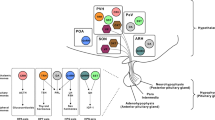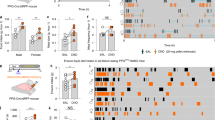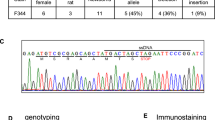Abstract
Neuropeptide Y (NPY), a 36-amino-acid peptide widely expressed in the brain1 is involved in many physiological responses2, including hypothalamic control of food intake and cardiovascular homeostasis. NPY mediates its effects through binding to the Y1, Y2 and Y5 G-protein-coupled receptors3,4,5,6. Little is known of the role of the Y2 receptor in mediating the different NPY effects. We inactivated the Y2 receptor subtype in mice and found that these mice developed increased body weight, food intake and fat deposition. The null mutant mice showed an attenuated response to leptin administration but a normal response to NPY-induced food intake and intact regulation of re-feeding and body weight after starvation. An absence of the Y2 receptor subtype also affected the basal control of heart rate, but did not influence blood pressure. These findings indicate an inhibitory role for the Y2 receptor subtype in the central regulation of body weight and control of food intake.
This is a preview of subscription content, access via your institution
Access options
Subscribe to this journal
Receive 12 print issues and online access
$209.00 per year
only $17.42 per issue
Buy this article
- Purchase on Springer Link
- Instant access to full article PDF
Prices may be subject to local taxes which are calculated during checkout



Similar content being viewed by others
References
De Quidt, M.E. & Emson, P.C. Distribution of neuropeptide Y-like immunoreactivity in the rat central nervous system. II. Immunohistohemical analysis. Neuroscience 18, 545– 618 (1986).
Wettstein, J.G., Earley, B. & Junien, J.L. Central nervous system pharmacology of neuropeptide Y. Pharmacol. Ther. 65, 397– 414 (1995).
Rose, P.M. et al. Cloning and functional expression of a cDNA encoding a human type 2 neuropeptide Y receptor. J. Biol. Chem. 270, 22661–22664 (1995).
Gerald, C. et al. Expression cloning and pharmacological characterization of a human hippocampal neuropeptide Y/peptide YY Y2 receptor subtype. J. Biol. Chem. 270, 26758–26776. (1995).
Eva, C., Keinänen, K., Monyer, H., Seeburg, P. & Sprengel, R. Molecular cloning of a novel G-coupled receptor that may belong to the neuropeptide receptor familly. FEBS Lett. 271, 81–84 ( 1990).
Gerald, C. et al. A receptor subtype involved in neuropeptide-Y-induced food intake. Nature 382, 168– 171 (1996).
Dumont, Y., Fournier, A., St-Pierre, S. & Quirion, R. Comparative characterization and autoradiographic distribution of neuropeptide Y receptor subtypes in the rat brain. J. Neurosci. 13, 73–86 (1993).
Naveilhan, P., Neveu, I., Arenas, E. & Ernfors, P. Complementary and overlapping expression of Y1, Y2 and Y5 receptors in the developing and adult mouse nervous system. Neuroscience 87, 289–302 (1998).
Edvinsson, L., Ekblad, E., Hakanson, R. & Wahlestedt, C. Neuropeptide Y potentiates the effect of various vasoconstrictor agents on rabbit blood vessels. Br. J. Pharmacol. 83, 519– 525 (1984).
Allen, J.M., Bircham, P.M., Edwards, A.V., Tatemato, K. & Bloom, S.R. Neuropeptide Y (NPY) reduces myocardial perfusion and inhibits the force of contraction of isolated perfused rabbit heart. Regul. Pept. 6, 247– 253 (1983).
Pedrazzini, T. et al. Cardiovascular response, feeding behavior and locomotor activity in mice lacking the NPY Y1 receptor. Nature Med. 4, 722–726 (1998).
Nilsson, T., You, J., Hedner, T. & Edvinsson, L. Characterization of neuropeptide Y receptors mediating contraction, potentiation and inhibition of relaxation. Blood Press. 5, 164– 169 (1996).
Zhang, X. et al. Expression and regulation of neuropeptide Y Y2 receptor in sensory and autonomic ganglia. Proc. Natl. Acad. Sci. USA 94, 729–734 (1997).
McDermott, B.J., Millar, B.C., Dolan, F.M. & Bell, D. Evidence for Y1 and Y2 subtypes of neuropeptide Y receptors linked to opposing postjunctional effects observed in rat cardiac myocytes. Eur. J. Pharmacol. 336, 257–265 (1997).
Stanley, B.G., Magdalin, W., Seirafi, A., Nguyen, M.M. & Leibowitz, S.F. Evidence for neuropeptide Y mediation of eating produced by food deprivation and for variant of the Y1 receptor mediating this peptide's effect. Peptides 13, 581–587 (1992).
Clark, J.T., Kalra, P.S., Crowley, W.R. & Kalra, S.P. Neuropeptide Y and human pancreatic polypeptide stimulate feeding behaviour in rats. Endocrinology 115, 427– 429 (1984).
Marsh, D.J., Hollopeter, G., Kafer, K.E. & Palmiter, R.D. Role of the Y5 neuropeptide Y receptor in feeding and obesity. Nature Med. 4, 718–721 ( 1998).
Kushi, A. et al. Obesity and mild hyperinsulinemia found in neuropeptide Y-Y1 receptor-deficient mice. Proc. Natl. Acad. Sci. USA 95, 15659–15664 (1998).
Broberger, C., Landry, M., Wong, H., J.N., W. & Hokfelt, T. Subtypes Y1 and Y2 of neuropeptide Y receptor are respectively expressed in pro-opiomelanocortin- and neuropeptide-Y-containing neurons of the rat hypothalamic arcuate nucleus. Neuroendocrinology 66, 393–408 (1997).
Schreyer, S.A., Wilson, D.L. & LeBoeuf, R.C. C57BL/6 mice fed high fat diets as models for diabetes-accelerated atherosclerosis. Atherosclerosis 136, 17 –24 (1998).
Girardier, L., Clark, M.G. & Seydoux, J. Thermogenesis associated with spontaneous activity: an important component of thermoregulatory needs in rats. J. Neurophysiol. 488, 779–787 ( 1995).
Zhang, Y. et al. Positional cloning of the mouse obese gene and its human homologue. Nature 372, 425– 432 (1994).
Erickson, J.C., Hollopeter, G. & Palmiter, R.D. Attenuation of the obesity syndrome of ob/ob Mice by the loss of neuropeptide Y. Science 274, 1704–1707 (1996).
Stephens, T.W. et al. The role of neuropeptide Y in the antiobesity action of the obese gene product. Nature 377, 530 –532 (1995).
Schwartz, M.W., Seeley, R.J., Campfield, L.A., Burn, P. & Baskin, D.G. Identification of targets of leptin action in rat hypothalamus. J. Clin. Invest. 98, 1101–1106 (1996).
Chen, X., DiMaggio, D.A., Han, S.P. & Wessfall, T.C. Autoreceptor-induced inhibition of neuropeptide Y release from PC-12 cells is mediated by Y2 receptors. Am. J. Physiol. 273, H1737–H1744 (1997).
Johansson, C. & Thorén, P. The effects of triiodothyronine (T3) on heart rate, temperature and ECG measured with telemetry in freely moving mice. Acta Physiol. Scand. 160, 133 –138 (1997).
Johansson, C., Vennström, B. & Thorén, P. Evidence that decreased heart rate in thyroid hormone receptor α1 deficient mice is an intrinsic defect. Am. J. Physiol. 44, R640–R646 (1998).
Acknowledgements
We thank P. Mombaerts for the gift of the IRES/tau/lacZ plasmid. We thank M. Byström, M. Edlund, H. Fält, O. Karlsson, M. Lindberg and U. Marklund for input in the creation and characterization of the polyclonal antibodies, and L. Amrut Fors for determination of the plasma components. We thank J. Wagner and S. Nyström for comments on the manuscript. This research was supported by the Swedish Medical Research Council and Kapten Arthur Ericssons Foundation to P.E. P.N. was a fellow of the WennerGren Foundation and Karolinska Institute, and J.M.C. was a fellow of the European Molecular Biology Organization.
Author information
Authors and Affiliations
Corresponding authors
Rights and permissions
About this article
Cite this article
Naveilhan, P., Hassani, H., Canals, J. et al. Normal feeding behavior, body weight and leptin response require the neuropeptide Y Y2 receptor. Nat Med 5, 1188–1193 (1999). https://doi.org/10.1038/13514
Received:
Accepted:
Issue Date:
DOI: https://doi.org/10.1038/13514
This article is cited by
-
Changes in white adipose tissue gene expression in a randomized control trial of dieting obese men with lowered serum testosterone alone or in combination with testosterone treatment
Endocrine (2021)
-
Role of NPY receptor 8 in regulating of food intake in Chinese perch (Siniperca chuatsi)
Aquaculture International (2021)
-
The timing of fasting leads to different levels of food consumption and PYY3–36 in nocturnal mice
Hormones (2020)
-
Meta-analyses between 18 candidate genetic markers and overweight/obesity
Diagnostic Pathology (2014)
-
The neuropeptide Y Y1 receptor knockdown modulates activator protein 1-involved feeding behavior in amphetamine-treated rats
Molecular Brain (2013)



